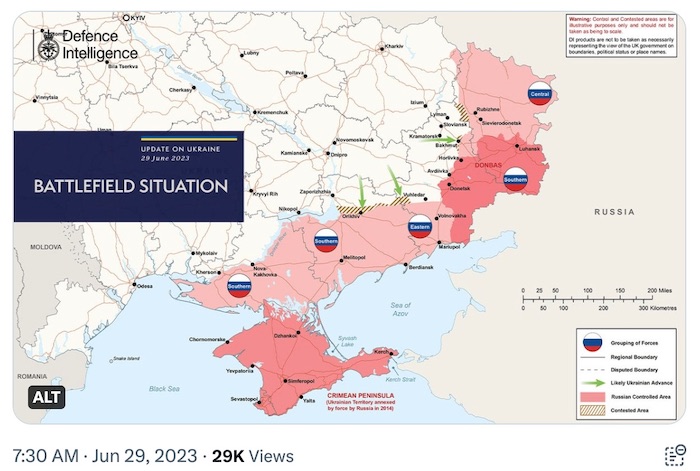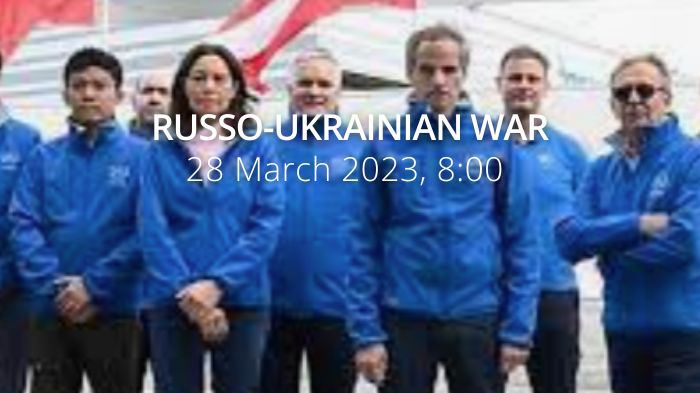Support for arming Ukraine soars in the US. Russian authorities reportedly arrested Army General Surovikin. Russian sources claimed that Ukrainian forces continued counteroffensive operations in western Zaporizhzhia Oblast and conducted limited probing attacks on the east (left) bank of the Dnipro River near the Antonivsky Bridge in Kherson Oblast.
Prigozhin planned to capture Defense Minister Shoigu and Chief of Staff Gerasimov but FSB found out - WSJ
The plot had a good chance of success before it was leaked, which forced Prigozhin to launch his attack 2 days early according to Western officialshttps://t.co/mEdkhcYJhm pic.twitter.com/lOLMBUJCo9
— Euromaidan Press (@EuromaidanPress) June 29, 2023
Daily overview — Summary report, June 29
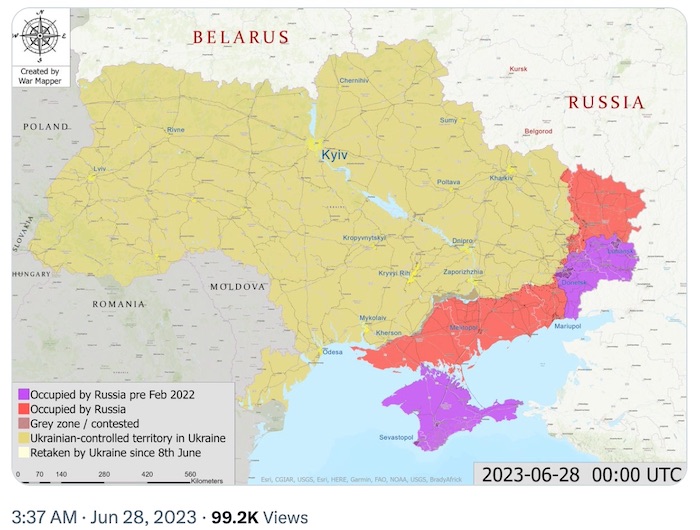
The General Staff’s operational update regarding the Russian invasion as of 18.00 pm, June 29, 2023 is in the dropdown menu below:
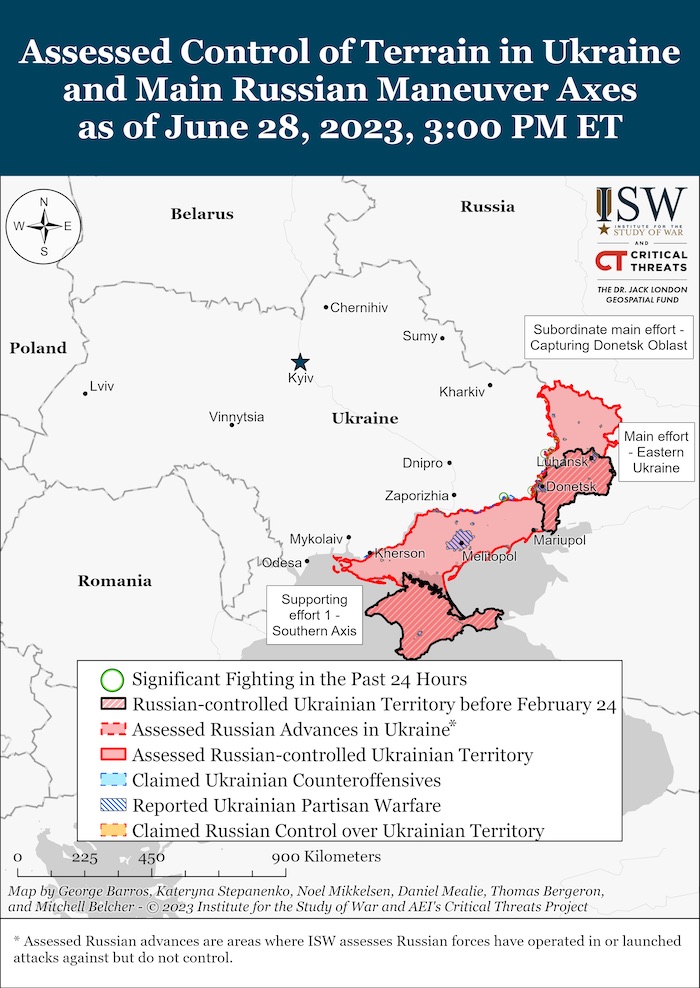
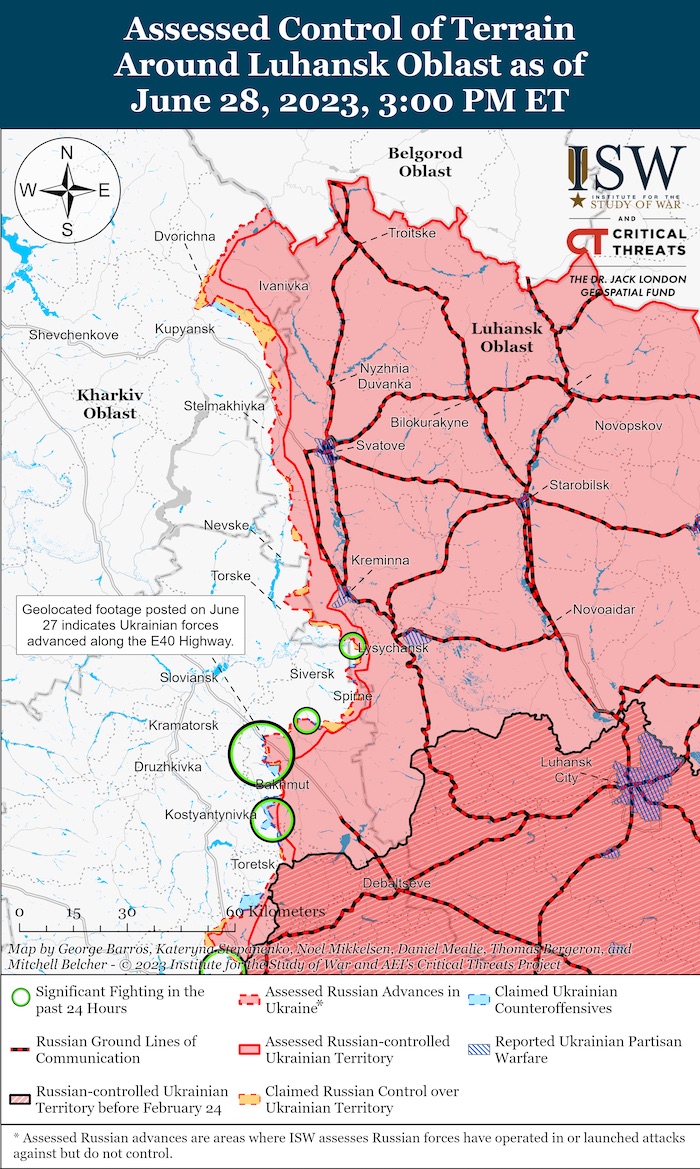
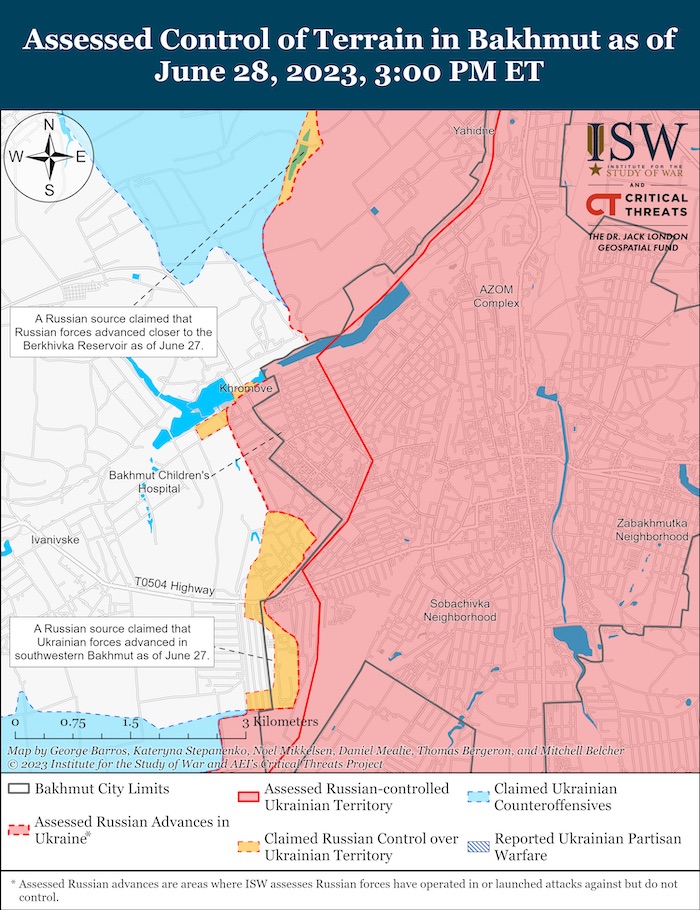
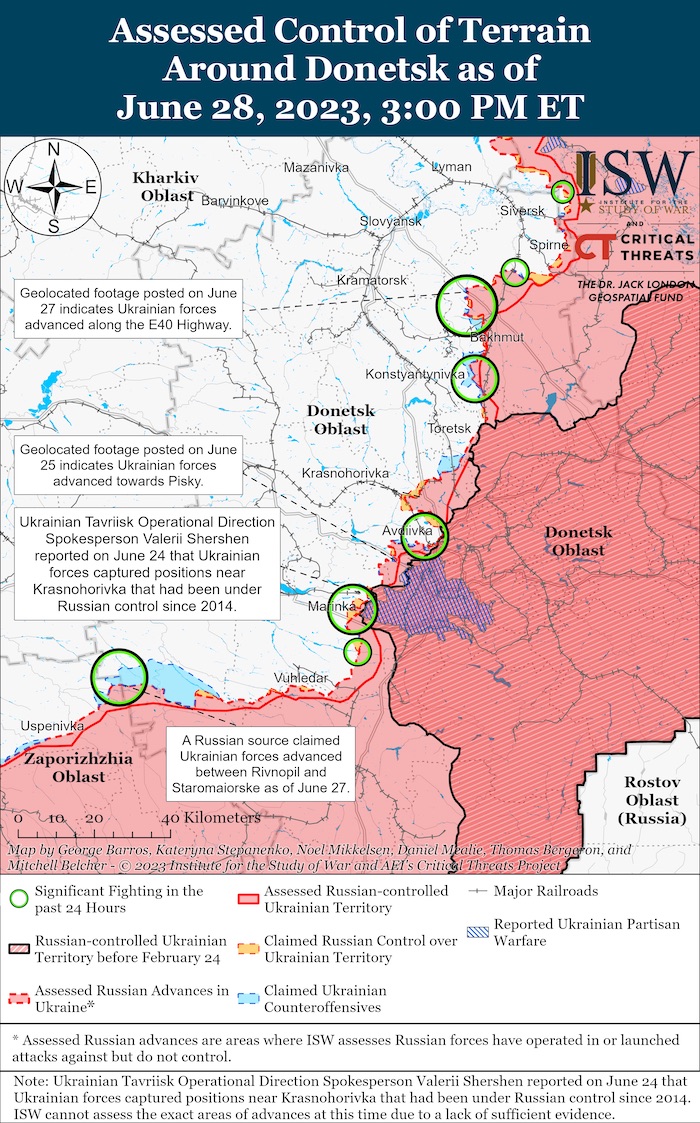
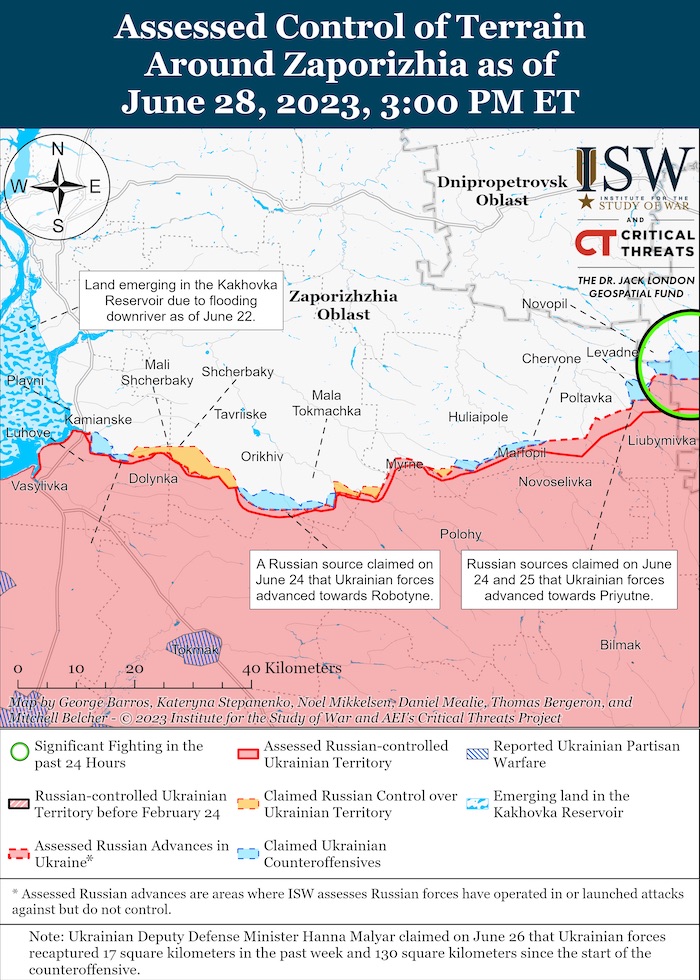
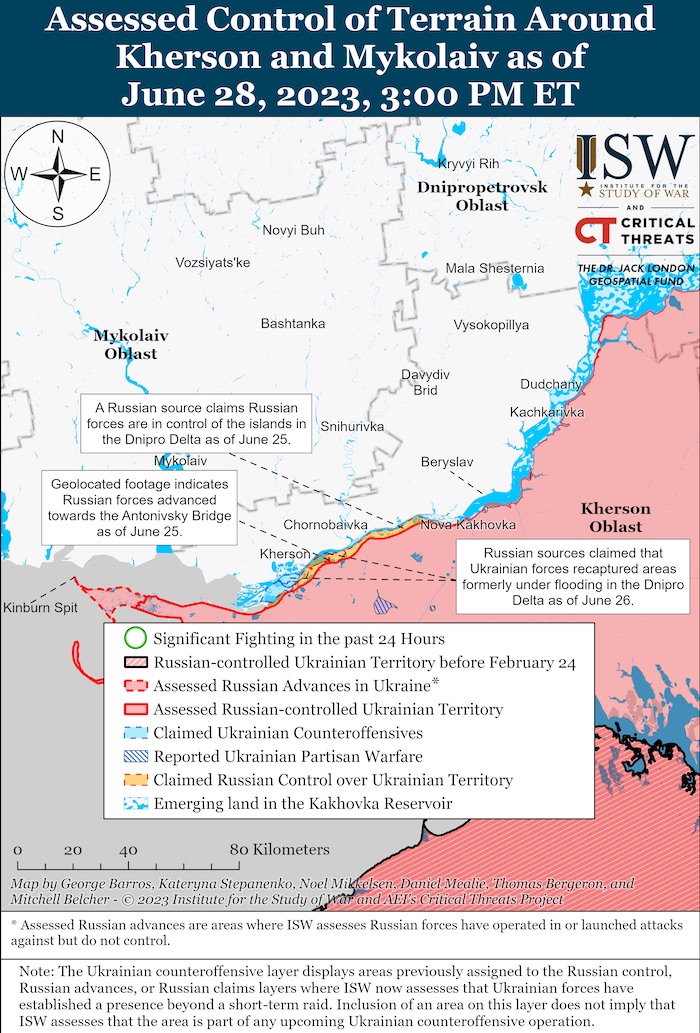
Military Updates
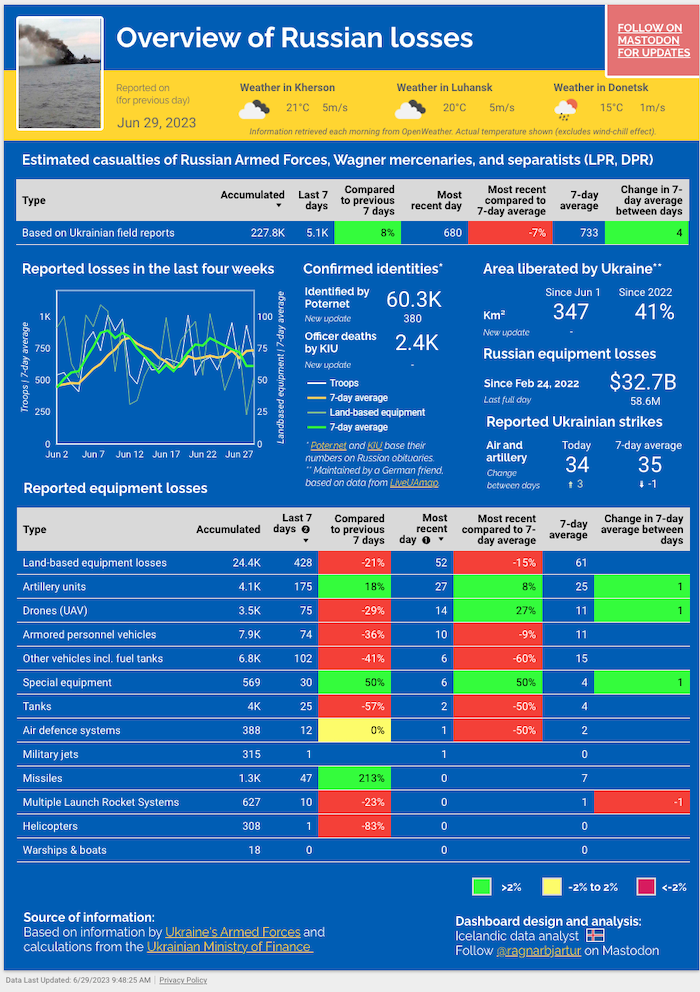
Ukrainian counteroffensive’s “main event” still to come – Defense Minister. Ukrainian Defense Minister Oleksii Reznikov told Financial Times that the liberation of several villages from Russian occupation in recent weeks was “not the main event” in the planned counteroffensive, and the attack’s main event is still to come. “When it happens, you will all see it . . . Everyone will see everything,” he said, disregarding media reports about the slow advance of the Ukrainian troops against heavily fortified Russian positions.
Missile strike on Chonhar bridge causes delays in Russian military logistics – British Intel. Russian military logistics convoys take twice as long to supply their troops on the frontlines in Zaporizhzhia Oblast (southeastern Ukraine) after the Ukrainian missile attack on the Chonhar bridge, British intelligence reported in its daily update on the Russo-Ukrainian war. On 22 June 2023, Ukrainian Armed Forces struck the Chonhar road bridges between the Russian-occupied Crimean Peninsula and Kherson Oblast in southern Ukraine. These bridges connect occupied Crimea with Kherson and Zaporizhzhia oblasts, being an important transportation route that Russia used to supply its forces in southern Ukraine via the Crimean Peninsula.
According to British Defence Intelligence, (last 48 hours):
- On 24 June, air defence forces of the Wagner private military company reportedly shot down Russian military helicopters and an Ilyushin Il-22M airborne command post aircraft.
- The Il-22M is part of a relatively small fleet of up to 12 aircraft, heavily utilised for both airborne command and control, and radio relay tasks. These special mission aircraft have played a key role in orchestrating Russian forces in their war against Ukraine. As high value assets they have operated within the safety of Russian airspace, far beyond the range of Ukrainian air defence systems.
- The loss of this aircraft is likely to have a negative impact on Russian air and land operations. In the short term the psychological shock of losing a large number of aircrew in this manner will almost certainly damage morale within the Russian Aerospace Force. In the longer term, there is a possibility that current tasking levels may have to be reduced to safely manage the remaining fleet. This will likely undermine Russia's ability to command and coordinate its forces, particularly during periods of high tempo operations.
Losses of the Russian army
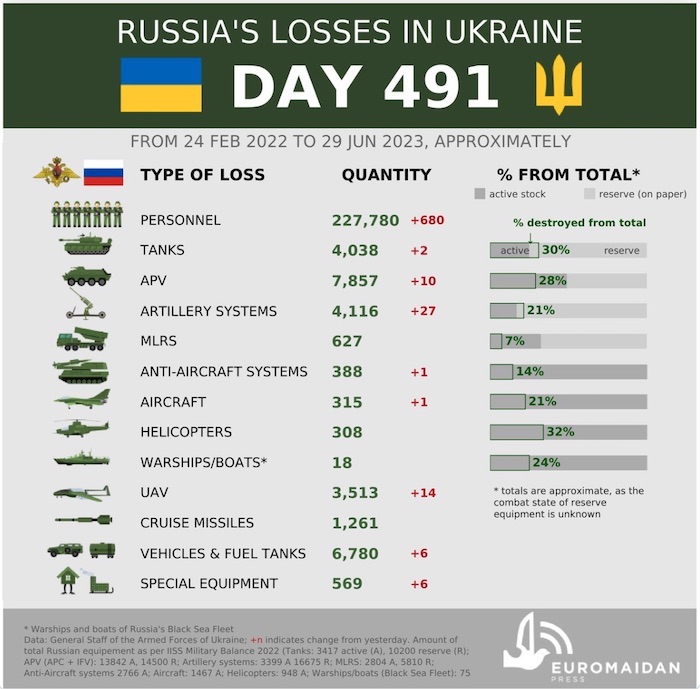
Humanitarian
Meet 7yo Oleksandra Paskal who radiates joy wherever she goes.
Despite losing her leg in Russian shelling in Odesa Obl, remains dedicated to her passion for rhythmic gymnastics.
After rehab, she again participates in competitions.Photoshoot "The Real Me" by Viktoria Yefremova pic.twitter.com/Pygq1Sz957
— Euromaidan Press (@EuromaidanPress) June 29, 2023
Russian shelling attack on northeastern Kharkiv Oblast kills three civilians, injures one. According to Kharkiv National Police, on 28 June, Russian troops fired mortars at the village of Vovchanski Khutory in Kharkiv Oblast’s Chuhuiv district, eastern Ukraine, killing three local residents on the spot. Earlier that morning, Russian troops used multiple rocket launchers to shell Kurylivka village in Kupiansk district of the same region, injuring a 69-year-old local woman, Prosecutor’s Office in Kharkiv Oblast reported.
Environmental
Russian military in control of Kakhovka dam during breach identified by Ukrainian journalists. Ukrainian investigative journalists have identified the Russian soldiers and their commanders who were in control of the Kakhovka Hydroelectric Station during its catastrophic destruction on 6 June.
https://twitter.com/EuromaidanPress/status/1674221393163214849
Legal
Former Kherson council head, his adviser get ten-year sentence for activist Handziuk’s murder. On 26 June, the Dnipro District Court of Kyiv announced the verdict in the case of Kherson activist Kateryna Handziuk’s murder, which happened back in 2018, finding two former Kherson regional officials guilty. The former head of the Kherson Regional Council, Vladyslav Manger, was found guilty of ordering the attack. Meanwhile, his assistant Oleksii Levin was found guilty of organizing it. The court has sentenced them to 10 years in prison, Ukrainian public broadcaster Suspilne reports.
Support
Switzerland expands sanctions on Russia in line with EU – CNN. On 28 June, the Swiss government said in a statement that Switzerland is expanding its sanctions on Russia to align with the latest round of sanctions by the European Union, on 28 June, CNN reported. The scope of the sanctions will be expanded to include individuals and organizations involved in facilitating the alleged illegal deportation of Ukrainian children to Russia, alongside Russian officials, military personnel, and members of the Wagner group. On 23 June, the EU imposed financial and travel sanctions on an additional 71 individuals and 33 entities. The Swiss government said that the assets of those sanctioned will be frozen in Switzerland, and the individuals concerned will be prohibited from entering or transiting the country.
Possibility of providing ATACMS missiles to Ukraine is high, US Senator says. The possibility of sending long-range ATACMS missiles to Ukraine is high, US Senator from Idaho, a member of the Republican Party, James E. Risch, said in his interview with the Voice of America. According to Risch, US lawmakers continue to pressure the Biden administration to provide Ukraine with all weapons it needs to repel the full-scale Russian invasion and defend itself.
Support for arming Ukraine soars in USA – Reuters/Ipsos survey. Most Americans support the US military aid to Ukraine, according to a Reuters/Ipsos survey. The majority of US citizens support providing weaponry to Ukraine to defend itself against the full-scale Russian invasion and believe that US military aid to Ukraine demonstrates a strong commitment of the United States to protecting American interests and allies, according to the Reuters/Ipsos survey.
Polish, Lithuanian presidents make surprise visit to Kyiv to back Ukraine’s NATO bid. On 28 June, presidents Gitanas Nausėda of Lithuania and Andrzej Duda of Poland arrived on an unannounced visit to Kyiv. “Ahead of the NATO summit in Vilnius with one main message – Ukraine’s place is in NATO,” Lithuanian President Gitanas Nausėda wrote on Twitter, sharing a video of his arrival.
Lithuania buys 2 NASAMS launchers for Ukraine, Lithuanian President announces. Lithuania purchased two National Advanced Surface-to-Air Missile System (NASAMS) launchers that will be donated to Ukraine, Lithuania‘s President Gitanas Nauseda announced on 28 June. NASAMS is a short/medium-range ground-based air defense system developed and produced by Norway’s company Kongsberg Defence and Aerospace and US aerospace and defense conglomerate Raytheon Technologies Corporation. NASAMS can take down unmanned aerial vehicles, helicopters, cruise missiles, and fixed-wing aircraft.
New Developments
Ukraine needs signal from NATO that country will join the Alliance after war ends, Zelenskyy says. Ukraine needs a signal that the country will join NATO after the Russo-Ukrainian war ends, Ukrainian President Volodymyr Zelenskyy said, according to The Guardian. “We understand that we cannot be a member of Nato during the war, but we need to be sure that after the war, we will be,” he told a press conference with the visiting Polish and Lithuanian presidents in Kyiv on 28 June. “That is the signal we want to get – that after the war Ukraine will be a member of NATO.”
Switzerland rejects sale of 96 Leopard 1 A5 tanks for use in Ukraine. Switzerland’s Federal Council rejected an application by Ruag AG to sell 96 Leopard 1 A5 main battle tanks for use in Ukraine, “as it contradicts current law,” according to a statement published by the Swiss government portal on 28 June. “Priority was thus given to aspects of Switzerland’s neutrality policy and its reliability as a constitutional state,” the statement reads.
Assessment
- On the war.
The Institute for the Study of War has made the following assessment as of June 28, 2022:
Continued reporting about the deal mediated by Belarusian dictator Aliaksandr Lukashenka to end the Wagner Group’s armed rebellion suggests that involved parties may still be negotiating the specifics of the agreement. Independent Belarusian monitoring group The Hajun Project cited flight tracking data on June 27 suggesting that Wagner Group financier Yevgeny Prigozhin’s jet took off from the Machulishchy airfield in Belarus towards Russia, flew to Moscow, and then immediately took off for St. Petersburg.[1] Former Russian officer and prominent critical milblogger Igor Girkin claimed that Prigozhin returned to Russia to negotiate with unspecified Russian officials and the Wagner Commander’s Council.[2] ISW cannot independently confirm if Prigozhin did in fact return to Russia, nor the details of the purported visit, but Prigozhin may have returned briefly to work out further details of the deal negotiated by Belarusian dictator Aliaksandr Lukashenka.
Russian sources continued to speculate on the specifics of this deal on June 28. A Wagner-affiliated Russian milblogger posted an interview with a Belarusian Wagner fighter wherein the fighter claimed that Wagner has opened a “new combat direction” in Belarus and that some Wagner fighters will “work in Russia” while some “work in Belarus.”[3] Russian opposition outlet Meduza, citing a source within the Russian Ministry of Defense (MoD) claimed that only 1,000 Wagner fighters went to Belarus with Prigozhin, however.[4] Belarusian opposition channel Belamova additionally claimed that satellite imagery from June 27 shows the construction of a new military object in the Osipovichi raion that was not visible as of June 13, suggesting that the imagery could show the construction of a Wagner training camp in Belarus.[5] It is unclear if construction of the military object appeared before the announcement of the Prigozhin-Lukashenka deal on June 24, and ISW cannot independently confirm if the object is in any way related to Wagner.[6] However, the pervasive speculation surrounding Wagner’s position in Belarus suggests that certain aspects of the deal are still being worked out.
Russian sources speculated that Wagner’s rebellion is already having widespread impacts on the Russian command structure. A prominent Russian milblogger claimed that Wagner’s rebellion has prompted “large-scale purges” among the command cadre of the Russian armed forces and that the Russian MoD is currently undergoing a “crash test” for loyalty.[7] The milblogger claimed that the Russian Federal Protective Service (FSO) is conducting a review of the Russian military leadership as well as the individual unit commanders.[8] The milblogger claimed that Russian officials are using the MoD’s “indecisiveness” in suppressing the rebellion and “support for paramilitary companies (PMCs)” as pretexts to remove “objectionable” personnel from their positions. The milblogger notably claimed that Russian Airborne Forces (VDV) commander and rumored deputy theater commander Colonel General Mikhail Teplinsky assumed responsibilities as overall theater commander in Ukraine from Chief of the General Staff and current overall theater commander Army General Valery Gerasimov on an unspecified date, but likely after the rebellion. The milblogger emphasized that Gerasimov will retain his post as Chief of the General Staff but will no longer have responsibilities for Russian operations in Ukraine. Another Russian source claimed that an “atmosphere of suspicion has enveloped the General Staff” and that affiliates of Gerasimov are accused of indecision and failure while the affiliates of deputy commander of the joint grouping of forces in Ukraine Army General Sergei Surovikin are accused of complicity in the rebellion.[9] The sources publishing these speculations have largely been accurate in previous reporting on Russian command changes, although the ongoing disruption to human networks and the severe potential consequences related to Prigozhin’s armed rebellion may affect these sources’ accuracy. ISW cannot confirm any of these speculations about the command changes at this time, but it is evident that the armed rebellion is continuing to have substantial ramifications in the information space.
Russian authorities reportedly arrested Army General Sergei Surovikin on June 28, possibly indicating that the Kremlin intends to purge the MoD of figures viewed as disloyal. Russian opposition source The Moscow Times reported on June 28 that two sources close to the MoD confirmed that the Russian authorities had arrested Surovikin because he chose to side with Prigozhin during the rebellion.[10] The New York Times reported on June 28 that US officials briefed on US intelligence stated that Surovikin had advance knowledge of the rebellion, but that US intelligence is still trying to ascertain if Surovikin directly supported Prigozhin’s effort.[11] It is unclear what transpired that would have forced Surovikin to call on Prigozhin to end the rebellion only several hours after its start, although it is possible that he did so under duress instead of out of support for the Russian military leadership. If Russian authorities did arrest Surovikin then the Kremlin will likely use Surovikin and his affiliates as scapegoats to publicly explain why the Russian military and Russian internal security apparatuses responded poorly to the rebellion and to justify a potential overhaul of the Russian military leadership. ISW has previously reported on Surovikin‘s notable Wagner affiliations and alleged support for Wagner, and Surovikin is a prime candidate for a scapegoat regardless of the actual level of support he gave to the rebellion.[12]
The Kremlin will likely attempt to balance a desire to mitigate the widespread disdain for MoD establishment figures that fueled Wagner’s rebellion while also trying to disempower those who may have sympathized with the rebellion. Segments of the pro-war ultranationalist community and the Russian military have routinely criticized Gerasimov and Russian Defense Minister Sergei Shoigu for their management of the war in Ukraine, and Prigozhin’s avowed goal of forcibly removing the two generals suggests that the Kremlin may view Gerasimov’s and Shoigu’s unpopularity as a direct threat to Putin’s ability to retain support among key constituencies and the military.[13] ISW previously assessed that the Kremlin is likely attempting to signal that Shoigu will maintain his position, but the Kremlin has yet to promote Gerasimov in a similar way in the days following the rebellion.[14] The Kremlin may attempt to placate disdain for the MoD establishment by reducing Gerasimov’s role in operations in Ukraine, although he is highly likely to maintain, at least nominally, the position of overall theater commander and his long-term role as Chief of the General Staff. ISW has previously assessed that Gerasimov’s removal from either position would be too damaging to Putin’s and the MoD’s reputation. Putin could attempt to avoid the fallout from future command changes by increasingly rewarding commanders with responsibility beyond their official positions.[15] Putin is likely further incentivized not to publicly replace Gerasimov out of fears of legitimizing rebellion as a successful means of blackmail. The speculations that Gerasimov’s role is diminishing in Ukraine may suggest that Putin is diverting Gerasimov to another effort instead of completely demoting him. Putin likely values Gerasimov for his loyalty above all else, and he may task Gerasimov with staff changes within the MoD focused on loyalty should the Kremlin decide to overhaul the Russian military leadership.[16]
The Kremlin may have chosen Teplinsky as a de facto overall theater commander because he is reportedly widely popular among the Russian rank-and-file and the Russian ultranationalist community.[17] Teplinsky previously commanded forces alongside Wagner around Bakhmut in the winter of 2023, but it is not immediately clear if Teplinsky supported Wagner more generally as Surovikin reportedly did, and Teplinsky remained silent during the armed rebellion.[18] Teplinsky reportedly expressed dissatisfaction with the current military command directly to Putin in late February and assumed a leading military command position in April 2023, becoming one of the most notable anti-Gerasimov commanders aside from Surovikin.[19] Teplinsky is allegedly in charge of sectors of the front where Russian forces are currently defending against Ukrainian counteroffensive operations, and speculations of his de facto appointment to overall theater commander may indicate that the Kremlin sought to reward Teplinsky for overseeing doctrinal Russian defensive operations in these areas of the front or to find a public face for the war effort who can claim credit for showing at least basic military competence to offset or distract from the attention Prigozhin had received for the seizure of Bakhmut.[20] The Kremlin may choose to assign responsibilities for command in Ukraine in such a way that Russian military officials privately recognize that an anti-Gerasimov figure controls the war effort in Ukraine without the Kremlin having to acknowledge that fact publicly. The Kremlin will likely struggle to balance between appeasing discontent with the MoD and purging it of disloyal figures without contradicting its rhetoric and actions. Should it find that balance too hard to strike it may choose to pursue only one of the goals. In that event, the Kremlin will almost certainly choose the effort of purging disloyal figures regardless of continued ire towards the MoD leadership.
Russian sources claimed that the Kremlin is punishing Russian forces that it perceives to have failed in their response to the rebellion. Russian milbloggers claimed that Russian pilots who refused to strike the Wagner convoys and Russian border guards who refused to open fire on Wagner are now facing unspecified criminal prosecution.[21] The Kremlin may punish lower-ranking Russian servicemen to create additional scapegoats for their response to the rebellion, although refusal to obey legal and direct orders would be grounds for courts martial in any military, and an order to fire on forces engaged in armed rebellion would very likely be legal. ISW cannot confirm these milblogger claims at this time.
The Russian Duma is considering additional measures to increase control over the information space and promote self-censorship within broad internet communities. First Deputy Chairperson for the State Duma Education Committee Yana Lantratova stated on June 27 that the State Duma will propose to appoint a body “authorized to monitor the activities of bloggers.”[22] Lantratova also stated that Duma deputies will submit an additional bill on the registration of bloggers as “mass media” and that defines the rights and obligations of bloggers.[23] While reporting on this bill does not specify military correspondents or milbloggers, it is likely that milbloggers will fall into the broad category of “bloggers” and will be subject to increased regulation and control by the proposed monitoring body and resultant bill. ISW has previously reported on the efforts of Russian authorities to increase censorship of milbloggers and military commentators.[24] The Duma may have suggested this law using the broad category of “blogger” to avoid drawing specific ire from milbloggers, who largely did not comment on these updates on July 28.
Belarus formally ratified an agreement on the establishment of joint Russian-Belarusian training centers in Belarus on June 28. Belarusian media reported that Belarusian deputies adopted a draft law on the ratification of an agreement between Russia and Belarus on the “establishment and operation of combat training centers for joint training of military personnel” of Belarusian and Russian military personnel.[25] Belarusian Defense Minister Viktor Khrenin noted that the main tasks of these combat training centers is the “unification of combat training” by Russian and Belarusian forces.[26] ISW previously assessed in April of 2021 that Russia opened such training centers in Belarus to set conditions for further permanent military basing as part of the wider Russian effort to entirely subordinate Belarus under Kremlin control.[27] The agreement on joint training centers was previously signed on March 28, 2023, on the basis of an October 31, 2022, draft treaty law.[28] The ratification of the pre-existing agreement is the next step in the Kremlin’s ongoing campaign to secure the military subordination of Belarus and is not related to the reported deal between Wagner Group financier Yevgeny Prigozhin and Belarusian dictator Aliaksandr Lukashenka on Wagner’s exile to Belarus following the June 23-24 armed rebellion.
Russian Defense Minister Sergei Shoigu held a phone conversation with the Chief of the General Staff of the Armed Forces of the Islamic Republic of Iran Major General Mohammad Bagheri on June 28. Russian media reported that Shoigu and Bagheri discussed issues of bilateral military and military-technical cooperation, regional security, and the wider international situation and announced their intention to deepen bilateral dialogue and develop additional defense contracts.[29] Bagheri is responsible for Iranian military policy and strategic guidance and previously met with Shoigu in Moscow in October 2021.[30] Bagheri's senior role within Iran's security apparatus suggests that he could be discussing arms sales with Shoigu. Iranian officials have previously expressed interest in receiving Russian fighter jets and air defense systems in return for Iran's support for the Russian war effort, though these sales have not yet materialized.[31] ISW and the Critical Threats Project had previously assessed that Iran is seeking to leverage arms sales to generate revenue for the Iranian economy.[32]
Unconfirmed reports claim that Russian military police allegedly detained Wagner Group commanders in Syria. Saudi Arabian TV channel Al Hadath reportedly stated on June 27 on air that Russian military police detained the head of Wagner’s branch in Suwayda, Syria, and three other “high-ranking” Wagner commanders at the Hmeimim Air Base and visited Wagner offices in Damascus, Hama, and Deir ez Zor.[33] Russian news outlet Kommersant reported that Wagner commander Dmitry Utkin later denied these claims of Wagner personnel arrests in Syria on his Telegram channel.[34] Another Wagner-affiliated Telegram channel also denied the arrests.[35] ISW is unable to independently verify these claims at this time.
Ukrainian forces conducted counteroffensive operations in at least four sectors of the front. The Ukrainian General Staff reported that Ukrainian forces are conducting offensive operations in the Bakhmut direction, along the western Donetsk-eastern Zaporizhzhia administrative border, and in western Zaporizhzhia.[36] The Russian MoD claimed that Russian forces repelled Ukrainian attacks south of Kreminna.[37] Ukrainian Defense Minister Oleksii Reznikov stated in an interview with Financial Times published on June 28 that the “main event” of the Ukrainian counteroffensive has not yet started.[38]
Key Takeaways
- Continued reporting about the deal mediated by Belarusian dictator Aliaksandr Lukashenka to end the Wagner Group’s armed rebellion suggests that involved parties may still be negotiating the specifics of the agreement.
- Russian sources speculated that Wagner’s rebellion is already having widespread impacts on the Russian command structure.
- Russian authorities reportedly arrested Army General Sergei Surovikin on June 28, possibly indicating that the Kremlin intends to purge the MoD of figures viewed as disloyal.
- The Kremlin will likely attempt to balance a desire to mitigate the widespread disdain for MoD establishment figures that fueled Wagner’s rebellion while also trying to disempower those who may have sympathized with the rebellion.
- The Russian Duma is considering additional measures to increase control over the information space and promote self-censorship within broad internet communities.
- Belarus formally ratified an agreement on the establishment of joint Russian-Belarusian training centers in Belarus on June 28.
- Russian Defense Minister Sergei Shoigu held a phone conversation with the Chief of the General Staff of the Armed Forces of the Islamic Republic of Iran Major General Mohammad Bagheri on June 28.
- Unconfirmed reports claim that Russian military police allegedly detained Wagner Group commanders in Syria.
- Ukrainian forces conducted counteroffensive operations in at least four sectors of the front.
- Russian and Ukrainian forces conducted ground attacks near Kreminna, Bakhmut, and in western Donetsk Oblast.
- Russian forces conducted a strike on civilian infrastructure in Kramatorsk in Donetsk Oblast on the night of June 27.
- Russian sources claimed that Ukrainian forces continued counteroffensive operations in western Zaporizhzhia Oblast and conducted limited probing attacks on the east (left) bank of the Dnipro River near the Antonivsky Bridge in Kherson Oblast on June 27 and 28.
- Russian sources reported on continued Russian efforts to clarify terms and conditions for military service.
- Russian and occupation officials continue efforts to deconflict legal discrepancies as part of the incorporation of occupied territories.


